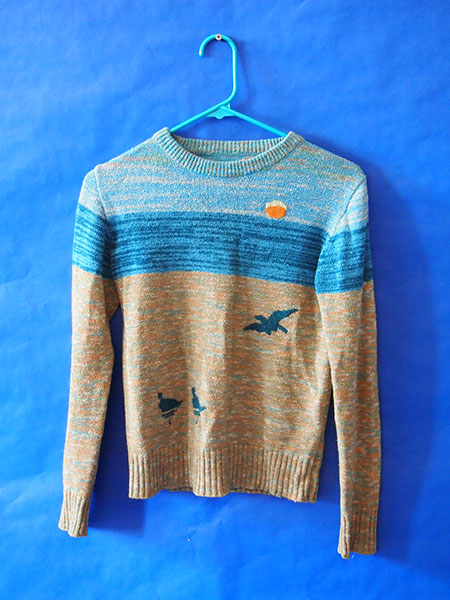![]() body | color | collections | commodity | cube | document | fabric | fetish | gender | glass | home | identity | living | machine | metal | minimal | mobility | narrative | olfactory | organic |
body | color | collections | commodity | cube | document | fabric | fetish | gender | glass | home | identity | living | machine | metal | minimal | mobility | narrative | olfactory | organic |
![]() pain | paper | plastic | plugs | power | protective | rectangular | ritual | round | sound | souvenir | spiritual | style | text-based | time | tool | touch | uniform | value | visual | warm | wood
pain | paper | plastic | plugs | power | protective | rectangular | ritual | round | sound | souvenir | spiritual | style | text-based | time | tool | touch | uniform | value | visual | warm | wood
| Clothing: Blue, Tan, and Orange Sweater | |||
Narrative: Blue, tan, and orange sweater The polymer is formed by free-radical polymerization in aqueous suspension. The fiber is produced by dissolving the polymer in a solvent such as N,N-dimethylformamide or aqueous sodium thiocyanate, metering it through a multi-hole spinnerette and coagulating the resultant filaments in an aqueous solution of the same solvent (wet spinning) or evaporating the solvent in a stream of heated inert gas (dry spinning). Washing, stretching, drying and crimping complete the processing. Acrylic fibers are produced in a range of deniers, typically from 0.9 to 15, as cut staple or as a 500,000 to 1 million filament tow. End uses include sweaters, hats, hand-knitting yarns, socks, rugs, awnings, boat covers, and upholstery; the fiber is also used as "PAN" precursor for carbon fiber. Production of acrylic fibers is centered in the Far East, Turkey, India, Mexico, and South America, though a number of European producers still continue to operate, including Dralon and Fisipe. US producers have ended production, though acrylic tow and staple are still spun into yarns in the USA. Actually a generic name to a class of polymers called alphaic polymers. Nylon is a synthetic fiber of a class of synthetic polymers developed in early to mid 1900’s. It was the world’s true first synthetic fiber. It is formally attributed to DuPont and Dr. Wallace Carouthers deemed the father of polymers. It is made by repeating bonds and is frequently referred to as a polymide. Nylon fibers specifically are made in a process known as “melt spinning”; syrupy polymer (adipic acid and hexamethylene diamine) solution produced then extruded through a spinneret. When fiber strings emerge they are cooled by air and stretched over rollers to stabilize molecular chains and strengthen the fibers. It was intended to replace silk and substituted for it in WWII including parachutes, flak vests, and vehicle parts including tires and that initiative enhanced speed of research and development. Currently joins rank with polyester in inexpensive mass manufacturing of goods – in 2010 & 2011 the global consumption of nylon was 4 Billion tons annually in filament yarn as well as fibers. This sweather was found at a thrift store in Boston, Ma in 1999. I was working for "The Closet Upstairs" a vintage shop on Newbury Street with Niki Tripodes, who would take me buying with her to second hand shops. At one point I found this for a few dollars. It's traveled with me from Boston, MA to Portland, OR to CT to Brooklyn, Queens, storage in Staten Island, Manhattan, and Brooklyn NY. |
 |
||
![]()
